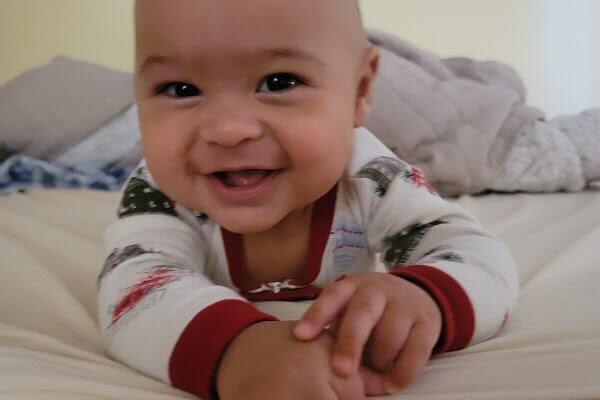By Alexa Joy Sherman
0-5 years
It’s easy to go gaga over your infant’s gummy grin, but before you know it, she’ll have a full set of new choppers. That should be something to smile about, too-if, that is, all 20 primary teeth are strong and healthy. Alas, early childhood caries (ECC), or tooth decay, is the most common chronic childhood disease in the U.S., five times more common than asthma and seven times more common than hay fever. Part of the problem: Parents may not realize how important baby teeth are. “Moms and dads figure they’re just going to fall out anyway,” says Arthur J. Nowak, DMD, executive director of the American Board of Pediatric Dentistry (ABPD) and professor emeritus of pediatric dentistry and pediatrics at the University of Iowa in Iowa City. “But in addition to being the placeholders for permanent teeth and jaw development, baby teeth are important for healthy eating habits, speech and so many other aspects of growth and development.”
Cavities can be serious, too. “Tooth decay can lead to pain, crying, irritability, not wanting to eat and not wanting to sleep,” notes Dr. Nowak. A study published in the journal Pediatric Dentistry even found a connection between ECC and malnutrition. Then there’s the drilling, filling and possibly even extractions, which can require sedation or general anesthesia-no fun for babies or the nervous parents looking on. Some research has suggested that ECC may be linked to diabetes and cardiovascular disease later in life, and let’s not forget about the impaired self-esteem and cosmetic concerns that come with dental decay.
Extreme as this all sounds, keeping your little one’s smile cavity-free is easier than you might think. It all starts with these simple steps.
STEP 1: Keep spit to yourself. ECC is an infectious disease that begins with cavity-causing bacteria, typically spread from caregiver to baby. “Sometimes mom or dad will try a bottle before giving it to a child, or they’ll share utensils during feedings,” explains Dr. Nowak, who also notes that many parents will “clean” a pacifier with their own mouth prior to giving it to their child. “Any of that back-and-forth passes the bacteria. Babies putting toys or fingers in their mouths that have been in others’ mouths can also be involved, but it’s mostly the sharing of utensils and even kissing.” So if you thought swapping saliva was safe between family members, consider this the exception to that particular “sharing is caring” rule.
STEP 2: Have a gum plan. Baby teeth begin to erupt at 5 or 6 months of age and continue to come in until about the age of 3-but even before the first one pokes through, clean the gums with a soft infant toothbrush, as recommended by the American Academy of Pediatric Dentistry (AAPD), or with a cloth and water, as suggested by American Academy of Pediatrics (AAP), at least occasionally (after the morning and/or evening feeding, for instance). Not only will this brace baby-as well as get you ready-for your child’s dental hygiene routine, but it can also provide some soothing pressure during the teething phase. “Parents can also help teething infants-who may be fussy, chew on objects and drool excessively-by offering a cooled chewing ring,” notes Indru C. Punwani, DDS, MSD, head of the department of pediatric dentistry at the University of Illinois at Chicago College of Dentistry, and spokesperson for the AAPD. Your pediatrician or pediatric dentist may prescribe an appropriately small dose of over-the-counter pain reliever for your teething baby as well.
STEP 3: Get it done in year one. Research suggests most parents wait until their children have reached age 3 or 4 to schedule that first oral exam, but both the AAPD and AAP recommend seeing a dentist as soon as the first tooth shows up-and by age 1 at the latest. That might sound premature, but it’s all about prevention. “At the first appointment, we go through a series of caries risk assessment questions that help us determine the likelihood of future dental problems,” says Dr. Nowak. “Based upon that, we can decide on fluoride treatments, dietary modifications and the frequency of checkups. It’s the ‘dental home’ for the infant, and we’re there to assist parents in promoting optimum oral health.” Some general dentists see babies, but pediatric dentists have an additional two or three years of kid-specific training, as well as experience making little ones comfortable-sometimes so much that tots can’t wait to return. Just click on the “Find a Pediatric Dentist” link at aapd.org to locate a provider in your area.
STEP 4: Brush, little baby. In addition to routine checkups (typically every six months), scrub each of your child’s teeth with water or a smear of toothpaste as soon as it comes in. The best brushes for kids have small heads and soft, polished bristles with large handles, and most dentists will recommend using a bit more toothpaste (a pea-size amount) after the age of 2. Aim to brush for two minutes at least two times a day-ideally after breakfast and last thing before bed (nighttime is especially important since we produce less saliva during sleep)-and toss brushes every few months. You can also floss your child’s teeth once a day when she is 2 to 3 years old, or as soon as the back molars come together, says Dr. Punwani. While you can certainly let your child try to clean her own teeth, plan on supervising for quite some time. “We say that until they can tie their own shoelaces, they cannot brush their own teeth,” notes Dr. Nowak. That’s usually around age 7 or 8-but as with anything, developmental milestones (and dexterity) will vary.
STEP 5: Mind the menu. They’re called “sugar bugs” for a reason: Cavity-causing bacteria feed on carbohydrates (simple and natural sugars) and then produce acid that de-mineralizes-or erodes-teeth. This doesn’t mean you must completely ban carbs, but be careful about what you offer, when, how often and for how long. For instance, the AAPD strongly advises against letting your baby fall asleep with a bottle containing anything other than water. “The acid from the sugar and the lack of saliva at night can lead to the development of decay over a few months,” notes Dr. Punwani. Even breast milk, if it’s constantly bathing the teeth, can cause cavities, so the AAPD also advises stopping at-will/nighttime nursing after baby’s teeth come in.
As your child gets older, limit all cavity-causing drinks to cups at meal or snack time (no bottles or sippy cups full of juice or even milk that can be consumed around the clock). Sticky foods like cookies, pretzels and even dried fruit and chewy vitamins should also be offered sparingly. “Sweets can be given in moderation as dessert at mealtimes, when there is ample salivary flow,” notes Dr. Punwani. Better bets-and ones that actually boost dental health: fresh fruits and vegetables (citrus, in particular, stimulates saliva production and can help rid the mouth of bacteria), as well as calcium-rich dairy products (studies have found cheeses including American, cheddar, jack and mozzarella can actually help reduce the risk of cavities, even in the presence of sugar, because they boost saliva production and neutralize plaque acids). Of course, water at the end of (and between) each meal and snack is a great way to wash away food particles when brushing isn’t an option.
Bottom line: Battling sugar bugs doesn’t have to be a mission impossible. By offering a balanced diet of wholesome foods at regularly scheduled meal and snack times-as well as sticking to the other steps offered here-your little one will have a set of champion choppers that everyone can smile about.
NEXT: WHAT TO DO WHEN THERE’S TOOTH PAIN
{pagebreak}
The Tooth Hurts
No matter how hard you try to keep your child’s teeth strong and healthy, accidents can happen. Precautions like baby-proofing your home and getting a mouth guard for athletic activities can help to prevent serious injuries. But if dental damage should occur, try not to panic (the mouth bleeds a lot, whether an injury is serious or not!). Simply call the dentist ASAP, and consider this situation-specific advice from the AAPD and Academy of General Dentistry (AGD):
o Chipped tooth
Most chips in baby teeth aren’t cause for concern and can be smoothed out or left alone. If the mouth or lips were injured, rinse with water, apply cold compresses to reduce swelling and/or consult your pediatrician or pediatric dentist to learn the appropriate dose of Children’s Tylenol to relieve pain.
o The wiggles
Kids begin to lose their baby teeth as early as age 4, but if a tooth has been knocked loose before that, try to keep it from falling out. Your dentist will probably recommend a soft diet for a few days in the hope that it will heal back into place-but may want to take an X-ray if more serious damage seems likely.
o Total knockout
If a baby tooth gets completely knocked out, it should never be replanted, as this could pose damage to the developing permanent tooth. Some dentists may put a fake tooth in place, but usually just for cosmetic reasons.
Taking care of baby teeth is essential—so brush up on the basics before that first pearly white even appears.




